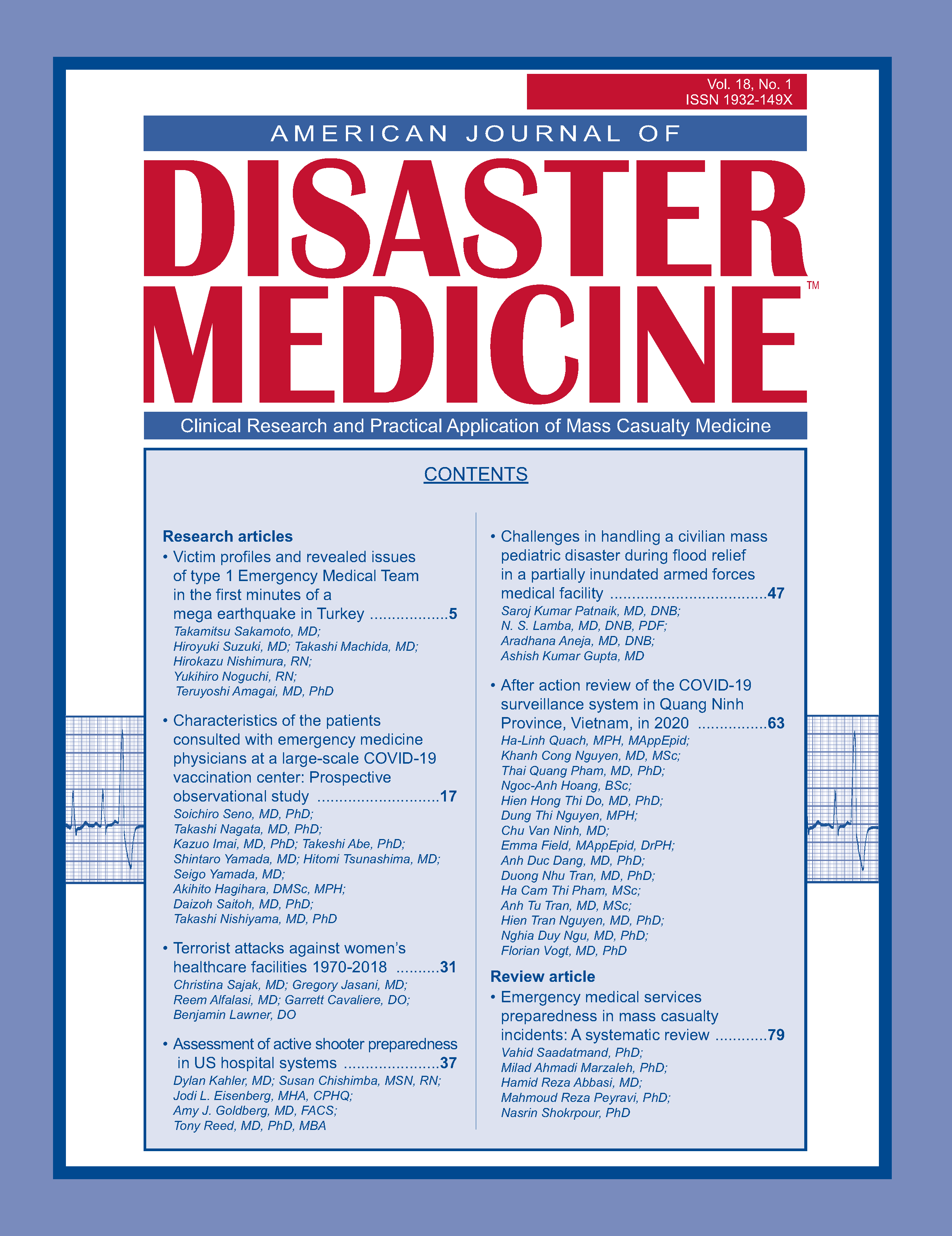Assessment of active shooter preparedness in US hospital systems
DOI:
https://doi.org/10.5055/ajdm.0458Keywords:
active shooter preparation, hospital preparedness, emergency preparedness, run-hide-fight, secure-preserve-defend, hemorrhage control techniquesAbstract
Background: Active shooter events are horrific, unfortunate realities in American hospitals. Protecting patients and staff in an active shooter event is made more difficult in the cases of critically ill and otherwise immobile patients. Previous work has proposed theoretical mitigation strategies for active shooter events. This study assesses American hospitals’ current, active preparedness plans.
Methods: This is a survey-based study with questionnaires distributed to leaders in American healthcare. The survey assessed current active shooter protocols with a particular emphasis on managing critically ill patients. Data were summarized with frequency and percentage.
Results: The survey was distributed to 294 hospital systems across the United States, and representatives from 60 hospital systems responded. Ninety-eight percent of these hospital systems have an active shooter protocol; 24 percent report a plan to provide care for critically ill patients. Among those hospital systems with a plan for caring for immobile patients, substantial heterogeneity exists in the philosophy and implementation of these protocols. Additionally, 52 percent of hospital systems routinely practice response drills to active shooter events. Notably, hospital systems that had experienced an active shooter event in the past were more likely to practice implementing active shooter protocols.
Conclusions: While most hospital systems have an active shooter protocol in place, these plans are infrequently practiced and generally do not include contingency arrangements for the sickest, immobile patients. The results from this study highlight a significant opportunity for improvement in American hospital safety procedures.
References
Kelen GD, Catlett CL, Kubit JG, et al.: Hospital-based shootings in the United States: 2000 to 2011. Ann Emerg Med. 2012; 60(6): 790-798.e1. DOI: 10.1016/j.annemergmed.2012.08.012.
Wax JR, Cartin A, Craig WY, et al.: US acute care hospital shootings, 2012-2016: A content analysis study. Work. 2019; 64(1): 77-83. DOI: 10.3233/WOR-192970.
Federal Bureau of Investigation: Active shooter incidents in the United States in 2016 and 2017. Available at https://www.fbi.gov/file-repository/active-shooter-incidents-us-2016-2017.pdf/view. Accessed April 10, 2023.
Federal Bureau of Investigation: Active shooter incidents in the United States in 2018. Available at https://www.fbi.gov/file-repository/active-shooter-incidents-in-the-us-2018-041019.pdf/view. Accessed April 10, 2023.
Federal Bureau of Investigation: Active shooter incidents in the United States in 2019. Available at https://www.fbi.gov/file-repository/active-shooter-incidents-in-the-us-2019-042820.pdf/view. Accessed April 10, 2023.
Federal Bureau of Investigation: Active shooter incidents in the United States in 2020. Available at https://www.fbi.gov/file-repository/active-shooter-incidents-in-the-us-2020-070121.pdf/view. Accessed April 10, 2023.
Federal Bureau of Investigation: Active shooter incidents in the United States in 2021. Available at https://www.fbi.gov/file-repository/active-shooter-incidents-in-the-us-2021-052422.pdf/view. Accessed April 10, 2023.
Hodge JG, Nelson K: Active shooters in health care settings: Prevention and response through law and policy. J Law Med Ethics. 2014; 42(2): 268-271. DOI: 10.1111/jlme.12141.
Sofer D: Responding to mass shootings. Am J Nurs. 2018; 118(9): 18-19.
Brennan P: Active shooter planning and response learn how to survive a shooting event in a healthcare setting. 2017. Available at https://www.fbi.gov/file-repository/active_shooter_planning_and_response_in_a_healthcare_setting.pdf/view. Accessed April 6, 2022.
Palestis K: Active shooters: What emergency nurses need to know. J Forens Nurs. 2016; 12(2): 74-79. DOI: 10.1097/JFN.0000000000000113.
Quick Safety 4 Active Shooters update 5 19 21: Quick safety. 2021. Available at https://www.jointcommission.org/resources/news-and-multimedia/newsletters/newsletters/quick-safety/quick-safety-issue-4-preparing-for-active-shooter-situations/preparing-for-active-shooter-situations-addendum-february-2017/#.YvZ1D3bMLq4. Accessed August 11, 2022.
Schwerin D, Thurman J, Goldstein S: Active shooter response. 2021. Available at https://pubmed.ncbi.nlm.nih.gov/30085609/. Accessed December 7, 2022.
Inaba K, Eastman AL, Jacobs LM, et al.: Active-shooter response at a health care facility Kenji. N Engl J Med. 2018; 24(382): 2368-2375.
Giwa A, Milsten A, Vieira D, et al.: Should I stay or should I go? A bioethical analysis of healthcare professionals’ and healthcare institutions’ moral obligations during active shooter incidents in hospitals—A narrative review of the literature. J Law Med Ethics. 2020; 48(2): 340-351. DOI: 10.1177/1073110520935348.
Clark KR, Bass SM, Boiteaux SK: Survey of educators’ preparedness to respond to active shooter incidents. Radiol Technol. 2019; 90(6): 541-551.
Scott-Herring M: Active shooter preparedness: Is your or ready? AORN J. 2022; 115(6): 546-551. DOI: 10.1002/aorn.13691.
Jasani GMJ, Hirshon JM: Emergency department active shooter training: A survey of current practices in 2020. Am J Disaster Med. 2021; 16(4): 263-269.
Malow BA, Galion A, Lu F, et al.: A REDCap-based model for online interventional research: Parent sleep education in Autism. J Clin Trans Sci. 2021; 5(1). DOI: 10.1017/cts.2021.798.
Harris PA, Taylor R, Thielke R, et al.: Research electronic data capture (REDCap)—A metadata-driven methodology and workflow process for providing translational research informatics support. J Biomed Inform. 2009; 42(2): 377-381. DOI: 10.1016/j.jbi.2008.08.010.
Braun V, Clarke V: Using thematic analysis in psychology. Qual Res Psychol. 2006; 3(2): 77-101. DOI: 10.1191/1478088706qp063oa.
Muret-Wagstaff SL, Faber DA, Gamboa AC, et al.: Increasing the effectiveness of “stop the bleed” training through stepwise mastery learning with deliberate practice. J Surg Educ. 2020; 77(5): 1146-1153. DOI: 10.1016/j.jsurg.2020.03.001.
Stop the bleed. Stop the bleed station: 2023. Available at https://www.bleedingkits.org/all-products/stop-the-bleed-stations.html. Accessed April 6, 2023.
AED brands: Lifepak 1000 AED. 2023. Available at https://www.aedbrands.com/product/physio-control-lifepak-1000-defibrillator/. Accessed April 6, 2023.
Akiyama C: Surviving an active shooter incident in the intensive care unit. Crit Care Nurs Q. 2020; 43(1): 3-8. DOI: 10.1097/CNQ.0000000000000286.
Jacobs LM, Burns KJ: The Hartford consensus: Survey of the public and healthcare professionals on active shooter events in hospitals. J Am College Surg. 2017; 225(3): 435-442. DOI: 10.1016/j.jamcollsurg.2017.06.009.
Walden M, Lovenstein A, Ramick A, et al.: Perceptions of the moral obligations of pediatric nurses during an active shooter event in a children’s hospital. J Pediatr Nurs. 2021; 60: 252-259. DOI: 10.1016/j.pedn.2021.07.014.
Landry G, Zimbro KS, Morgan MK, et al.: The effect of an active shooter response intervention on hospital employees’ response knowledge, perceived program usefulness, and perceived organizational preparedness. J Healthc Risk Manag. 2018; 38(1): 9-14. DOI: 10.1002/jhrm.21313.
Dukes K, Bunch JL, Chan PS, et al.: Assessment of rapid response teams at top-performing hospitals for in-hospital cardiac arrest. JAMA Intern Med. 2019; 179(10): 1398-1405. DOI: 10.1001/jamainternmed.2019.2420.
Published
How to Cite
Issue
Section
License
Copyright 2007-2025, Weston Medical Publishing, LLC and American Journal of Disaster Medicine. All Rights Reserved.


